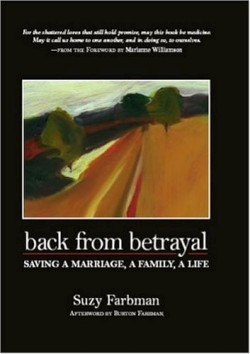Back From Betrayal
Saving a Marriage a Family a Life
In 1967, the author and her husband exchanged wedding vows, promising to love one another “till death do us part.” After more than thirty years together, Suzy suspects Burton of being unfaithful, but is determined not to let their once-blissful union come undone. With breathtaking honesty, Farbman, a former regional editor for Better Homes and Gardens and contributor to Women’s Wear Daily and Cosmopolitan, discloses the spiritual journey that healed a relationship seemingly ravaged beyond repair.
The Farbmans are members of the “S” generation, writes Suzy, “cultural straddlers who came of age in the ’60s.” Like many long-married couples, as the years passed, the differences between them became more pronounced. After decades working dawn to dusk as a real estate developer, fifty-something Burton is ready to retire. But Suzy, who had set aside her magazine publishing career to raise sons David and Andy, has many stories left to write.
When Burton begins disappearing for long periods of time, Suzy signs them up for a session at Onsite, a Nashville, Tennessee-based New Age retreat center that caters to couples in crisis. Burton reluctantly agrees to go. In a setting where participants gather in circles and bare their souls, Burton confesses to his wife in the confines of their room: yes, he says, he’s been sexually involved with not one, but several women.
Farbman conveys her visceral reaction in vivid, no-frills prose. “The words slammed into my gut,” she writes. “I thought I’d come here to learn the truth. Now I realized I didn’t want the truth after all. I wanted something safe and sanitized, not … a grim reality that could force me to change my life.” The next day, in the presence of fellow Onsite couples, the Farbmans vow to one another to try and make their marriage work. When they return to their once-comfortable suburban Detroit home, reality sets in. And the rocky road to rehabilitation begins.
Farbman warns that coming “back from betrayal” requires more than a band-aid solution; it demands ‘round-the-clock devotion to nurse a devastating wound. She provides detailed accounts of the couple’s continued counseling, as each comes to terms with the past. “We can’t change what has happened,” writes Farbman. “We can only change how we look at it. We can dwell on blame and regret. Or choose to forgive, learn and move on.”
Farbman, who consulted “spirit” guides, astrologists, and a cranio-sacral massage therapist, says the most transformative experience of all was writing this book (Burton says his piece, too, in the final chapter, “Giving Up Deceit”). While cynics might cringe at the mystical nature of the Farbmans’ mending ways, others may find hope in this story of a bruised and battered marriage brought back from the brink.
Reviewed by
Allison Block
Disclosure: This article is not an endorsement, but a review. The publisher of this book provided free copies of the book to have their book reviewed by a professional reviewer. No fee was paid by the publisher for this review. Foreword Reviews only recommends books that we love. Foreword Magazine, Inc. is disclosing this in accordance with the Federal Trade Commission’s 16 CFR, Part 255.

